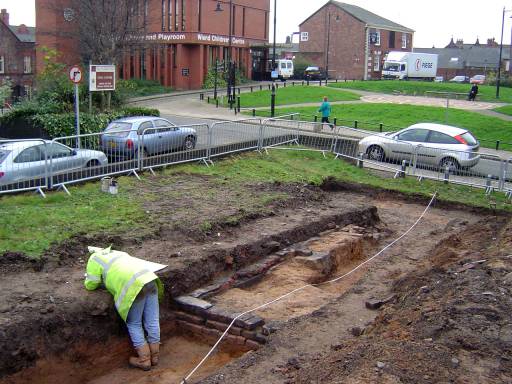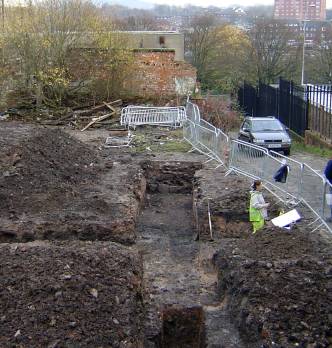 A programme
of survey and evaluation has been scheduled in advance of development that will see a huge
area in the centre of Wigan transformed into a new shopping complex covering 3.25 hectares
in all (see Newsletter 52). A programme
of survey and evaluation has been scheduled in advance of development that will see a huge
area in the centre of Wigan transformed into a new shopping complex covering 3.25 hectares
in all (see Newsletter 52).
The first trenches have now been dug which will hopefully reveal the extent of the
archaeological potential. Two areas have initially been targeted - Ship Yard and
Burrow’s Yard, both of which lie on the east side of Millgate leading down to Station
Road. The project is being run by Oxford Archaeology North (formerly Lancaster
Archaeology) and Ian Miller as the project manager. Ian has told me that further trenches
are planned for the car park in Station Road and on the other side of the Civic Centre
near Penningtons furniture shop.
The car park is on the site of the old Central Railway Station which was originally built
on an artificial mound to make it level with Station Road. There is every chance that much
archaeology has been preserved under this mound. The original course of the River Douglas
was diverted further west in the construction of the mound and coring has been scheduled
in this area to determine the depth of the archaeology.
Excavations are at an early stage but already material is emerging in Ship Yard relating
to the late medieval burgess plots. These were a common feature in the Medieval period in
Wigan’s town centre. The Burrow’s Yard site is next to the Civic Centre and is
particularly important as it lies directly opposite The Weind, where evidence of Roman
occupation was discovered in the early eighties.
 Ian
is confident that results from all these sites will show a wealth of archaeological
remains which will require full scale excavations. These will probably take place in the
spring and the size of the project may provide opportunities for us to get involved.
Ram Pump update
Tom has been searching through the archives to see if there are any records relating to
the commissioning of the pump but with little success. He has, however, obtained detailed
plans of the installation which show that the pump was housed in an underground pump room
with a glass inspection panel. The plans do not show where the housing was located but Tom
has also found out that the Barley Brook was culvertted in 1910. As this is the most
likely source of water, we probably know the date when the pump stopped working.
Pulham Landscape
It seems that the waterfall feature in Mesnes Park was the creation of the renowned
landscape gardeners James Pulham and Sons who produced grand landscapes throughout the
19th and early 20th centuries. These were created for many famous people including the
Royal Estates at Sandringham and Buckingham Palace. Many of their water features included
artificial rock which was developed from their own specially prepared Portland cement
called Pulhamite. The local society called ‘Friends of Mesnes Park’ had always
suspected that it was Pulhams’ work and when this was confirmed in 2002 they were
able to successfully apply for a grant from the BTCVs People's and Places Award Scheme.
This will be used to help restore the feature. The confirmation came from Claude Hitching,
a former employee who has a fascinating Website telling the whole story of the Pulham
Legacy – the site is at:
www.pulham.org.uk
Research Framework
Assessment chapters for the North West Research Framework are now available on the
Internet for general perusal and comment. The address is:
www.liverpoolmuseum.org.uk/ARF
Chapters include the following periods: Prehistoric, Romano-British, Early Medieval,
Medieval, Post-Medieval, Industrial and Modern. If anybody wants a printout of any of
these please let me know at the next meeting.
Next Meeting
Wednesday 1st December at the Baden Powel Centre (Scout HQ) in Greenough Street,
starting at 7.30 pm as usual. This month we have Dr David Shotter from
Lancaster University who is the foremost authority on the Roman period in the North West.
His talk will be about the Roman Conquest in the North West.
Hope to see
you there. B.A.
|



